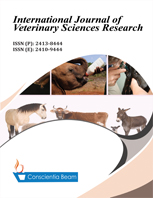Establishing Short Bowel Syndrome in Nigerian Dogs
DOI:
https://doi.org/10.18488/journal.110.2017.31.9.14Abstract
Determining the relationship between percentage resection and development of short bowel syndrome is important as it provides information on the expected outcome of the resection carried out which will enable the surgeon to prepare adequately to manage such patients. Ten adult Nigerian indigenous dogs with mean body weight 11.2 kg were used in this study. The animals were premedicated with atropine (0.04mg/kg) and xylazine (1mg/kg) intramuscularly. Anaesthesia was induced with thiopentone sodium (10mg/kg) intravenously. The abdominal cavity was entered through the ventral midline incision. Three animals each were subjected to 50% and 60% small intestinal resection while four animals were subjected to 70% small intestinal resection. The animals subjected to 50% and 60% intestinal resection did not manifest signs of short bowel syndrome. However, the animals subjected to 70% small intestinal resection manifested clinical signs attributable to short bowel syndrome. The animals subjected to 50% and 60% small intestinal resection had remnant small intestinal tract of up to 100cm while dogs that underwent 70% resection had remnant small intestinal bowel length of less than 100 cm. It is therefore, concluded that 70% small intestinal length resection is the minimum that can produce short bowel syndrome in Nigerian dogs and animals with remnant small bowel length of less than 100 cm after undergoing resection will come down with short bowel syndrome.

